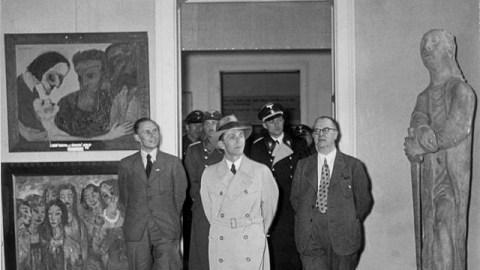Did the Nazis Inadvertently Globalize Modern Art?

For all the ugliness of Nazism in thought and deed, it’s striking to consider just how much they contemplated the arts. From the failed painter Adolf Hitler to the failed architect Albert Speer to the failed art collector Herman Göring, the Nazis spent an inordinate amount of time focused on what art was good and what art was bad. But “bad” wasn’t strong enough a term. “Degenerate art” irked them so much they actually staged an entire art exhibit around art they deemed a sign of degenerate morals, mental illness, and, of course, Judaism. The exhibit, titled Entartete Kunst in German, marked the end of Europe as the center of modern art and spread both the artists and their ideas around the world in a cultural diaspora of unprecedented proportions, thus accelerating a process that might have taken decades otherwise (if at all). Did the Nazis inadvertently globalize modern art?
The notorious Entartete Kunst exhibition reentered the news recently with the announcement of a memorial to be built in the village of Elterwater in Cumbria, England, to commemorate the artists involved in the show. Why Cumbria? The memorial will be built near the Merz Barn, a stone barn in which one of the exiled artists, Kurt Schwitters, worked until his death in 1948. Schwitters will be the subject of a major Tate exhibition early next year and there’s an even more ambitious plan to build a Schwitters museum in Elterwater, too. When Schwitters fled the Nazis and moved to England, he brought Dada along with him. The Merz Barn itself was just the latest “Merz” house transformed by Schwitters into a work of art. Likewise, Schwitters’ influence changed the course British art up to an including present-day paragon Damien Hirst.
A similar memorial could be built in New York City, where other modern artists such as Marcel Duchamp brought Dada and Surrealism to American shores in force. While the 1913 Armory Show introduced modern art to American artists, that event pales in comparison to the full-scale invasion of the “Degenerate” artists in the late 1930s and early 1940s. Thanks to Duchamp and friends personally influencing American art, everything from Abstract Expressionism to Pop Art to Minimalism reflected that instant influx of European modernism. In fact, without the Nazis driving those artists overseas, the shift in the center of the art world from Paris to New York City would have happened much more slowly, if at all. As the Philadelphia Museum of Art’s new exhibition Dancing around the Bride: Cage, Cunningham, Johns, Rauschenberg, and Duchamp, American modernism literally “danced” around Duchamp as the center of its world.
Until these memorials are built, however, we might want to consider this online memorial (sadly incomplete) recreating through photographs and records the Entartete Kunst exhibition itself. You can almost imagine yourself walking through the show and seeing Nazi Reich Minister of Propaganda Joseph Goebbels smugly perusing his handiwork personally (shown above). To the left of Goebbels are two paintings by Emil Nolde—Christus und die Sünderin (Christ and the Sinner; top left; from 1926) and Die klugen und die törichten Jungfrauen (The Wise and Foolish Virgins; bottom left; from 1910). Nolde actually supported the Nazis early on, only to be repaid by the label of degenerate and inclusion in the exhibition. The Nazis eventually made it illegal for Nolde and other degenerate artists who remained in Germany to paint anymore and would even periodically check in on them to make sure no new paintings were made. Nolde turned to watercolors during this period to avoid the tell-tale odor of oil paint that would give him away.
Perhaps someday a memorial will be built in Germany to these artists and the extent to which the Nazis went to extinguish their creative influence, only to have that effort backfire and instead ignite artists around the world to follow their example. Near the Entartete Kunst exhibition, the Nazis set up a parallel exhibition of what they felt illustrated good, truly German art. Among oversized statues of nude Teutonic manhood, a painting of Hitler himself in the guise of a shining knight by Hubert Lanzinger titled The Standard Bearerset the standard for overwrought political kitsch. In a world perhaps too full of memorials as it is, it seems that a memorial to the Degenerate Art exhibition and what it achieved in the face of totalitarianism seems long overdue.
[Image: Nazi Reich Minister of Propaganda Joseph Goebbels views the Degenerate Art exhibition in Munich, Germany, in 1937. Image source.]




